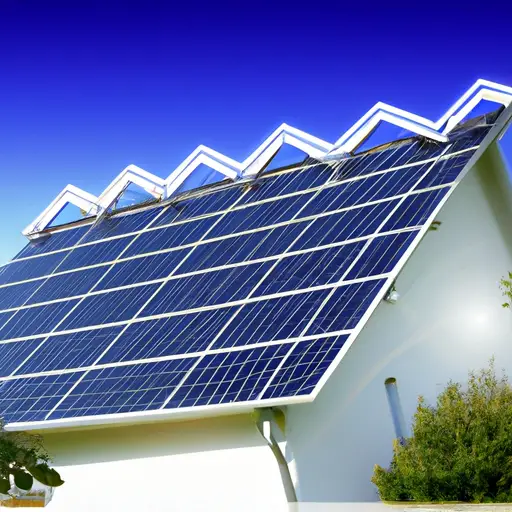So, you’ve been dreaming about having a self-sufficient home, huh? Well, you’re not alone. In today’s world, the idea of living off the grid and being self-sustainable is becoming more and more popular. But let’s face it, building a self-sufficient home is no small feat. That’s why we’re here to give you the lowdown on where to start and what you need to know. Whether it’s setting up solar panels or growing your own food, we’ve got you covered. Get ready to take the first steps towards your self-sufficient dream!

Choosing a Location for Your Self-Sufficient Home
Consider Local Laws and Regulations
When choosing a location for your self-sufficient home, it’s important to consider the local laws and regulations that may impact your plans. Each region may have specific zoning requirements, building codes, and restrictions that you need to adhere to. Researching and understanding these regulations beforehand will save you time and frustration in the long run.
Assess Access to Basic Resources
Access to basic resources such as water, electricity, and waste management is crucial for a self-sufficient home. Before deciding on a location, assess the availability and quality of these resources. Is there a reliable water source nearby? Are there electricity transmission lines in the area? Understanding the existing infrastructure will help you plan for alternative solutions if necessary.
Evaluate Climate and Natural Resources
The climate and natural resources of your chosen location play a significant role in the viability of your self-sufficient home. Consider factors such as sunlight exposure, wind patterns, and local vegetation. These elements will influence the design and functionality of your home, especially when it comes to energy production and food cultivation.
Designing a Self-Sufficient Home
Determine Your Goals and Needs
Before diving into the design process, it’s important to determine your goals and needs for your self-sufficient home. Are you looking to minimize your environmental impact, reduce utility bills, or achieve complete independence from external resources? Understanding your priorities will help guide the design decisions and ensure that your home meets your specific requirements.
Optimize Energy Efficiency
Energy efficiency should be a top priority when designing a self-sufficient home. Incorporate energy-efficient practices such as effective insulation, sealing air leaks, and using energy-efficient appliances. These measures will reduce the amount of energy needed to power your home and decrease your reliance on external sources.
Incorporate Solar Power
Harnessing solar power is a popular choice for off-grid homes. Install solar panels strategically to maximize sunlight exposure and generate sufficient electricity for your needs. Consider the orientation and tilt of the panels, as well as the storage capacity of the battery system, to ensure efficient utilization of solar energy.
Implement Natural Ventilation and Passive Cooling
To minimize the need for artificial cooling systems, design your home with natural ventilation and passive cooling strategies. Position windows and openings to take advantage of prevailing winds and create cross-ventilation. Incorporate shading elements such as awnings or trees to reduce heat gain from direct sunlight. These strategies will help maintain a comfortable temperature without relying heavily on energy-intensive cooling methods.
Collect and Store Rainwater
Water is a precious resource, especially in self-sufficient homes. Implement a rainwater harvesting system to collect and store rainwater for various household uses. Install gutters and downspouts to direct rainwater into storage tanks or barrels. Consider incorporating a filtration system to ensure the water quality meets your needs.
Use Sustainable Building Materials
When building a self-sufficient home, opt for sustainable building materials that have minimal environmental impact. Use materials such as bamboo, reclaimed wood, or recycled concrete. These materials are renewable, resource-efficient, and have a lower carbon footprint compared to traditional building materials.
Generating Power Off the Grid
Install Solar Panels
Solar panels are a reliable and eco-friendly way to generate electricity off the grid. Install solar panels on rooftops or open spaces with maximum sunlight exposure. Ensure that the panels are properly maintained and cleaned regularly to optimize their efficiency and longevity.
Consider Wind Turbines
In regions with consistent wind patterns, wind turbines can be an effective power generation option. Assess the average wind speeds and consult with professionals to determine the feasibility of wind turbines for your location. Wind turbines can be installed on tall towers or rooftops to harness the kinetic energy of the wind and convert it into electricity.
Explore Small-Scale Hydroelectric Power
If you have access to a water source with sufficient flow, small-scale hydroelectric power can be a viable option. Install a turbine or waterwheel to convert the flowing water’s energy into electricity. Make sure to consider any permits or environmental impact assessments required for such installations.
Utilize Biomass Energy
Biomass energy involves utilizing organic materials such as wood, crop waste, or animal manure to produce heat or electricity. Consider installing biomass heating systems or biogas digesters to convert organic waste into usable energy. This can be a sustainable way to generate power while reducing waste.
Ensuring Water Supply and Management
Install Rainwater Harvesting System
As mentioned earlier, installing a rainwater harvesting system is essential for self-sufficient homes. Rainwater can be used for various purposes such as irrigation, toilet flushing, and laundry. Filter the harvested rainwater to remove any impurities and ensure its safety for use.
Implement Greywater Recycling
Greywater recycling involves reusing water from sinks, showers, and washing machines for non-drinking purposes. Implement a greywater recycling system to treat and reuse this water, thereby reducing overall water consumption. Consult local regulations and guidelines to ensure compliance and safe usage.
Consider Well Water
If available, well water can be a reliable and self-sustaining water source for your home. Conduct a thorough assessment of the water quality and quantity before relying solely on well water. Install a robust pumping and filtration system to ensure a continuous and safe water supply.
Explore Water Filtration and Purification Systems
Regardless of your water source, it’s crucial to have a reliable water filtration and purification system in place. Invest in quality filters and treatment methods to remove impurities and pathogens, ensuring the water you consume is safe and potable.

Sustainable Food Production
Establish a Vegetable Garden
Growing your own vegetables is a key component of self-sufficiency. Design and establish a vegetable garden to produce fresh and organic produce for your household. Consider factors such as sunlight exposure, soil quality, and water availability when choosing the location for your garden.
Consider Aquaponics or Hydroponics
Aquaponics and hydroponics are innovative systems that allow you to cultivate plants in water without soil. These systems use the waste produced by aquatic animals as a nutrient source, creating a symbiotic relationship. Consider incorporating aquaponics or hydroponics to maximize your food production capabilities.
Incorporate Permaculture Principles
Permaculture is a design system that integrates sustainable agricultural practices, ecological principles, and human needs. Incorporating permaculture principles such as companion planting, natural pest control, and soil regeneration can enhance the productivity and resilience of your food production systems.
Raise Backyard Livestock
If local regulations permit, consider raising backyard livestock such as chickens, rabbits, or goats. Livestock can provide a sustainable source of meat, eggs, milk, and fertilizer. However, ensure that you have adequate space, resources, and knowledge to responsibly care for and manage the animals.
Waste Management and Composting
Implement Composting Systems
Composting is a natural process that converts organic waste into nutrient-rich compost for gardening. Implement composting systems to manage and utilize food scraps, yard waste, and other organic materials. Compost bins or vermiculture systems can turn these waste products into valuable resources for your garden.
Use Biodegradable and Eco-Friendly Products
Reduce your environmental impact by using biodegradable and eco-friendly products. Choose cleaning supplies, personal care products, and packaging materials that are biodegradable and produced using sustainable practices. This conscious choice will minimize the accumulation of non-recyclable waste in your self-sufficient home.
Minimize Waste and Recycle
Adopt a zero-waste mindset by minimizing waste generation and practicing recycling. Use reusable containers, cloth bags, and refillable bottles to reduce single-use plastic consumption. Establish a recycling system to properly sort and dispose of recyclable materials, ensuring their proper treatment and reducing landfill waste.

Heating and Cooling Self-Sufficient Homes
Utilize Passive Solar Design
Passive solar design utilizes the sun’s energy to heat and cool your home without the need for mechanical systems. Design your home with large windows on the south-facing side to maximize sunlight exposure during winter. Utilize thermal mass materials such as concrete or stone to store and release heat, maintaining a comfortable temperature throughout the year.
Install Energy-Efficient Heating Systems
Choose energy-efficient heating systems such as high-efficiency wood stoves, pellet stoves, or radiant floor heating. These systems use renewable or low-emission fuels and distribute heat effectively, reducing energy consumption.
Explore Biomass Heating
Biomass heating systems utilize organic materials as a fuel source for heating. Consider installing a biomass boiler or fireplace that runs on wood pellets or agricultural waste. Before implementing biomass heating, ensure a sustainable and local supply of biomass fuel.
Consider Geothermal Heating and Cooling
Geothermal heating and cooling systems utilize the stable temperature of the earth to regulate indoor climate. These systems use underground pipes to transfer heat in winter and remove heat in summer. Although the upfront costs of geothermal systems may be higher, they offer long-term energy savings and minimal environmental impact.
Building an Off-Grid Water and Energy Monitoring System
Implement Smart Energy Meters
Install smart energy meters to monitor and track your energy consumption. These meters provide real-time data on your energy usage, allowing you to identify areas for improvement and adjust your habits accordingly. This information is crucial for optimizing your power generation systems and reducing wasteful energy usage.
Monitor Water Usage with Smart Technology
Use smart technology and water monitoring systems to track your water usage. Smart water meters can provide valuable insights into your consumption patterns, helping you identify leaks, inefficient fixtures, or excessive water usage. By understanding your water usage, you can implement conservation strategies and reduce water wastage.
Use Energy Efficient Appliances and Electronics
Invest in energy-efficient appliances and electronics to minimize your energy consumption. Look for devices with ENERGY STAR ratings, as they meet strict energy efficiency guidelines. Regularly maintain and update these appliances to ensure optimal performance and energy savings in your self-sufficient home.

Self-Sufficient Home Maintenance and Repairs
Learn Basic DIY Skills
Learning basic do-it-yourself (DIY) skills is essential for maintaining and repairing your self-sufficient home. Acquire knowledge in areas such as plumbing, electrical work, carpentry, and general maintenance. By being self-sufficient in these tasks, you can save money and ensure that your home functions optimally.
Maintain and Monitor Solar Panels
Regularly maintain and monitor your solar panels to maximize their efficiency and lifespan. Keep them clean and free from debris that may obstruct sunlight. Monitor their performance and seek professional assistance if any issues arise. By properly caring for your solar panels, you can ensure a consistent and reliable source of clean energy.
Regularly Service Water Systems
Maintenance and regular servicing of your water systems are crucial for their longevity and efficient operation. Periodically check for leaks, ensure proper water pressure, and clean or replace filters as needed. By consistently maintaining and monitoring your water systems, you can avoid costly repairs and ensure a sustainable water supply.
Maintain and Repair Energy-Efficient Appliances
Maintain and repair your energy-efficient appliances to optimize their performance and extend their lifespan. Follow manufacturer’s instructions for regular maintenance, clean filters, and address any repairs promptly. By keeping your appliances in good working condition, you can reduce energy consumption and avoid the need for premature replacement.
Financing and Budgeting for a Self-Sufficient Home
Research Available Grants and Incentives
When planning for a self-sufficient home, research available grants, incentives, and tax credits that can offset the initial costs. Many governments and organizations offer financial assistance to promote sustainable and off-grid living. Take advantage of these opportunities to reduce your financial burden and make the transition to self-sufficiency more affordable.
Estimate Initial Costs and Long-Term Savings
Estimate the initial costs involved in building and setting up your self-sufficient home. This includes factors such as land acquisition, construction materials, renewable energy systems, and water management systems. Additionally, calculate the long-term savings you will incur by reducing or eliminating utility bills. Understanding the financial aspects will help you budget effectively and make informed decisions throughout the process.
Consider Financing Options
If you require financial assistance to build your self-sufficient home, consider various financing options available. Research loans, grants, and alternative financing models specifically designed for sustainable and off-grid projects. Consult with financial institutions and professionals in the industry to explore the most suitable financing options for your needs.
By following these comprehensive guidelines, you can embark on the journey of creating your self-sufficient home. Remember that each step towards sustainability contributes to a healthier environment and a more resilient future. With careful planning, research, and commitment, you can achieve the dream of living off the grid while minimizing your ecological footprint.





